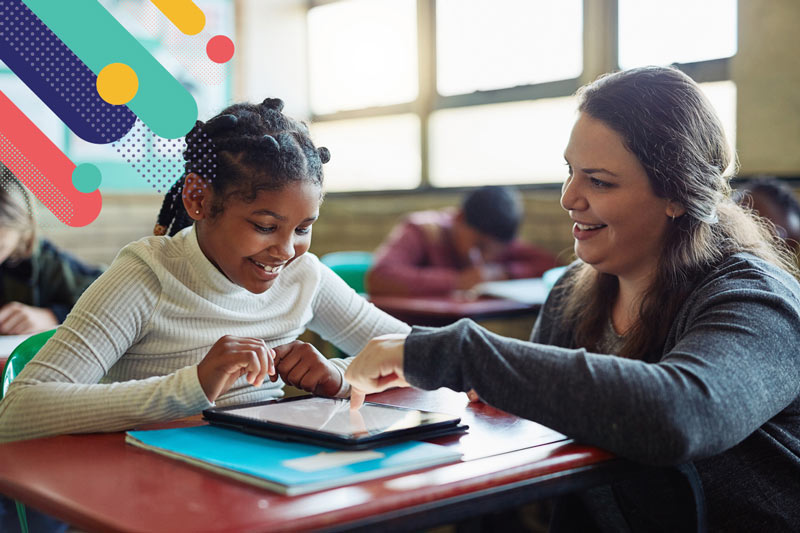TeacherVision Advisory Board Member Mikaela reminds us that getting feedback is vital to growth in our teaching practice. She shares actionable steps (both big and small) you can take to seek feedback and support from colleagues and through professional development.

We talk a lot about setting goals with students, enabling growth mindsets for our class, and monitoring student progress - but are we doing the same for ourselves?
Some school cultures have teacher development built in. For some of us, though, it can often feel like we are alone in a boat, trying to move forward, but unsure if we are headed in the right direction or simply paddling around in circles when it comes to our professional growth.
If you are blessed with a strong school culture that is focused on teacher development, be sure to share the love and wisdom you receive with other educators! If you not, don’t worry. There are many things you can start doing quickly that will help you develop and refine your skills in the classroom, as long as you’re willing to step out of your comfort zone.
Open Door Policy
An open door policy means that your door is always open for other teachers to come in and observe what you are doing. However, just opening your door during the day is not enough to express to your colleagues that you are ready for feedback and support. Make it explicitly clear that they are welcome to step in and observe at any time, and that you are open to any feedback that they can provide. If telling everyone feels overwhelming, start with one coworker you trust and set up a time for them to come in, take notes and then meet after the lesson to discuss what they saw. When you feel more comfortable, you can extend the invitation to more people.
Be sure to return the favor as well. Watching other teachers and providing feedback is just as valuable as being observed. If a colleague comes into your room and provides feedback, set up a time to do the same in their classroom.
Set Specific Goals and Measure Your Progress
This is as simple as using the same advice we give our students: In order for goals to be most effective, they need to be specific. Specific goals give you a clear objective and can be more easily chunked into steps. While setting goals independently is perfectly fine, consider involving a colleague or partner who can hold you accountable in the process. For more on goal setting, check out How To Turn Teaching Goals Into Teaching Habits.
A partner can also help you measure your progress. With your open door policy, you will be able to find someone willing to come in and see if you’re meeting your goals. Devise a way to measure your progress beforehand. For example, try using anecdotal notes, in the form of a chart or graph, or a formal coaching cycle. Use what you have available and what is easiest for you to understand and reflect on.
Find a Mentor or Create a PLC
Whether you are a 25-year veteran, a fresh first-year teacher, or somewhere in between, it's very useful to have a mentor. A good mentor is a valuable guide, someone you can bounce ideas off of and turn to when you’re struggling with a student, class, parent, or administrator. It can be intimidating, but don’t be afraid to ask a teacher you admire or like to be your mentor. The great thing about mentorship is that it can a be flexible relationship - as ad hoc or involved as you need it to be.
Once you have found a mentor, set aside regular time to watch them in action both in the classroom and in other situations. Bring a notebook or note-catcher and take lots of notes! If your schedules don’t allow for you to be in each other’s classrooms, you can film yourselves and set a time to review the videos.
You don’t have to limit yourself to one mentor - you can even create a formal or informal professional learning community (PLC) to engage other colleagues in the process. You can help each other improve by setting up a regular observation and feedback cycle.
Observational Learning Walks
Learning walks are another way to get into other teachers’ classrooms and observe a lesson. It is important to remember that a learning walk is not an evaluation tool, but rather a way to see what methods other teachers are using and how students respond to those methods. Because it is a structured observation, it is important that the teachers participating in the learning walk have clear objectives. For example, observers could be looking for how a teacher uses learning targets within their lesson. Learning walks should be followed by structured time for teachers to share what they saw and devise a plan for how they will improve their own instruction based on their observations.
Learning walks should be non-invasive. This means that observers entering the classroom does not disrupt the flow or intrude on the lesson. It can take time to build a culture in which students understand and know to keep working even if there are multiple teachers coming into their classroom. Letting students know that the purpose of the walks is to help other teachers improve can go a long way. It helps students recognize that everyone in the school is working on improving and strengthening their practices.
Find Professional Development Conferences
There are many, many opportunities for professional development across the country and throughout the year. If your school provides a budget, take advantage of it and commit to finding one conference or seminar that is relevant to helping you improve your practice. If you’re not sure where to start, look at your curricula. Which curricula are you still having difficulty implementing or seeing results with? Go to a conference focused on your curriculum! If you don’t have a budget, look for grants. There are many opportunities to receive funding.
Resources like the NEA Foundation have lists of available grants, but even a quick search on the internet will yield a lot of genuine results! Commiting to one conference a year will give you something to look forward to and get you in the room with lots of other brilliant educators.
Each of these strategies has been shown to help teachers improve their instruction. Start with one strategy that feels accessible to you and make it a regular practice. Invite others into your classroom. They’ll bring, experience, feedback, skills and company. You will feel stronger and you’ll be making those around you stronger too. What do you have to lose?
What are your growth strategies? Share with us on Instagram, Facebook, Twitter, and Pinterest.
Mikaela Prego is an elementary educator from Massachusetts. She spent the last 3 years teaching 4th grade in Colorado, now she is back teaching in Massachusetts. Her favorite subjects to teach are math, science and social studies and she is a huge fan of putting the students in charge of as much of their learning as possible. You can follow her classroom (@whoareweintheworld) on Instagram.











